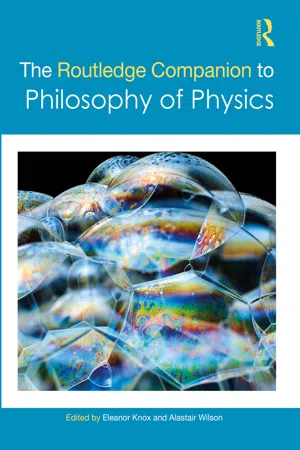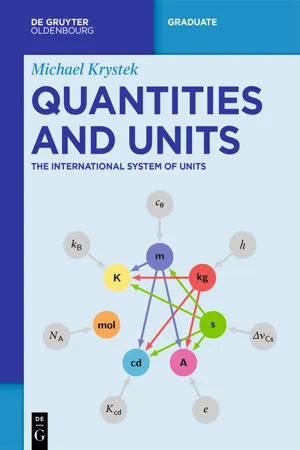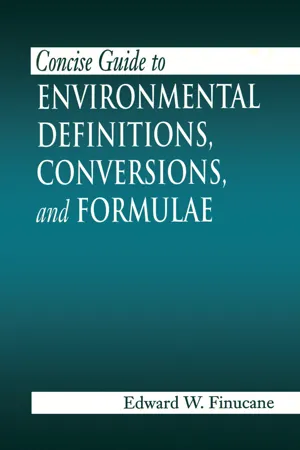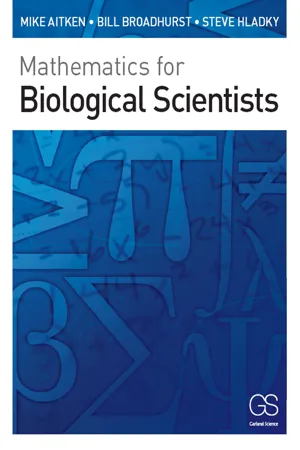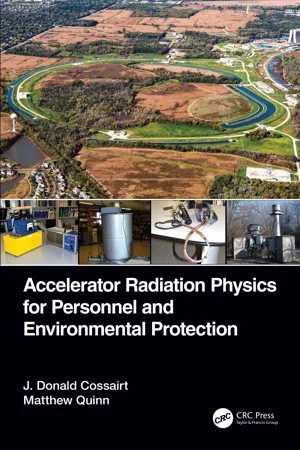Physics
Use of SI Units
The use of SI units in physics provides a standardized system for measuring physical quantities such as length, mass, time, and temperature. This system simplifies communication and ensures consistency in scientific measurements and calculations across different experiments and research. The SI units are based on fundamental constants of nature, making them universally applicable and reliable for scientific work.
Written by Perlego with AI-assistance
Related key terms
8 Key excerpts on "Use of SI Units"
- eBook - ePub
- Eleanor Knox, Alastair Wilson, Eleanor Knox, Alastair Wilson(Authors)
- 2021(Publication Date)
- Routledge(Publisher)
Quinn, 2011 ).Box 48.1 Definition of the International System of Units (from Bureau International des Poids et Mesures)The value of the fundamental constants are set in terms of the units to be defined, and the units are collectively defined in terms of the fundamental constants as a result. For example, as shown in Box 48.1 , the velocity of light is no longer a measured quantity. (Rather, its value is set in units of second and meter, which has the effect of defining the meter in terms of it as a fundamental constant of nature. All seven units that have historically been designated as base units are collectively defined in terms of the seven fundamental constants shown in Box 48.1 .) Since the value of the fundamental constants is set, rather than measured, the values of the fundamental constants have zero uncertainty.The official wording of the revised SI system, including the definition of the units, took effect in May 2019 (Box 48.1 ). Here we are especially interested in how dimensions will be treated since the switch to defining all units in terms of fundamental constants. The Ninth SI Brochure reads as follows:2.3.3 Dimensions of quantitiesPhysical quantities can be organized in a system of dimensions, where the system used is decided by convention. Each of the seven base quantities used in the SI is regarded as having its own dimension.48.2.7 Importance of Dimensions in Philosophy of Science
Dimensions, units, and quantities are distinct notions. We have seen above how they are related in the design of coherent systems of units; the account involves the equations of physics. When the use of a coherent system of units can be presumed, dimensional analysis is a powerful logico-mathematical method for deriving equations and relations in physics, and for parameterizing equations in terms of dimensionless parameters, which allows identifying physically similar systems. The source of the information yielded by dimensional analysis is not yet well understood in the philosophy of physics. This chapter has attempted to reveal not only the role of dimensions in applications of dimensional analysis to obtain information by involving the principle of dimensional homogeneity but also the role of dimensions in encoding information about physical relationships in the language of dimensions, specifically via the feature of coherence of a system of units. - eBook - ePub
- Atef Korchef(Author)
- 2022(Publication Date)
- CRC Press(Publisher)
2 Measurements
DOI: 10.1201/9781003257059-22.1 Objectives
At the end of the present chapter, the student should be able to:- Select the appropriate units in the International System of Units (known by the international abbreviation SI) of measurement.
- Differentiate between fundamental quantity and derived quantity.
- Convert units.
- Define and use the basic methods and tools of measurements, such as significant figures and rounding off.
2.2 Measurements
Measurement is the process of comparing an unknown quantity with another known quantity of the same kind to find out how many times the first includes the second.- Physical quantities are either fundamental (basic) quantities or derived quantities.
- Fundamental quantities cannot be defined in terms of other physical quantities.Examples: length, time, mass, temperature and amount of a substance.
Quantity consists of a number telling us how much, and a unit which shows what the scale of measurement is. Examples of base units in SI are given in Table 2.1 . SI base units of mass, temperature and amount of a substance (kg, K and mol, respectively) are widely used by chemists (Table 2.1 ).TABLE 2.1 Examples of SI base units
Note that:Base quantity SI base unit Name Symbol Name Symbol Length l, x, r, etc meter m Mass m kilogram kg Time t second s Temperature T Kelvin K Amount of a substance n mole mol - The SI unit of mass is kg (with small or lowercase k), not Kg (with capital K).
- The SI unit of the amount of a substance (mole) is denoted by mol (without an “e”), not mole. Also, kg is not the SI base unit for the amount of a substance but the SI unit of mass.
- eBook - ePub
Quantities and Units
The International System of Units
- Michael Krystek(Author)
- 2023(Publication Date)
- De Gruyter Oldenbourg(Publisher)
defining constants were selected on the basis of the advances in precision metrology during the past decades and in consideration of the practical application of the existing definitions of the SI units.For the realization of the definitions of the SI units, experimental methods called mises en pratique have been elaborated by the advisory committees of the CIPM, the descriptions of which are available on the BIPM website. They will be revised in the future whenever new experimental methods are developed on the basis of new scientific knowledge.For the realization of the unit of time, intensive work is currently in progress in order to reduce the measurement uncertainty by two to three orders of magnitude by means of optical clocks. It is therefore to be expected that the definition of the unit of time in the SI will change again in a not too far future.Individual countries have laid down rules for the use of units by national legislation either for general use or for specific fields, as e. g. commerce, health, public safety and education. In almost all countries, this legislation is based on the SI. The International Organisation of Legal Metrology (OIML) is in charge of the international harmonization of the technical specifications of these legal regulations.3.3 Definition of the base units
The revision of the SI in 2019 has changed the wording of the definitions for all seven base units. However, for the unit of length, the metre, the unit of time, the second, and the unit of luminous intensity, the candela, the physical concept underlying the respective definition has not changed.The basic concept of the new definitions of base units is that all base units are now defined by relations of values of the defining constants listed in table 3.1 .Tab. 3.1: - No longer available |Learn more
- Steven Boone, Drew H. Wolfe(Authors)
- 2011(Publication Date)
- Collins Reference(Publisher)
CHAPTER 2Chemical Measurements
I n this chapter, we will first discuss the International Standard of Units, the measurement system used by scientists throughout the world. Then, we will consider uncertainty in measurements and significant figures.2.1 INTERNATIONAL SYSTEM OF UNITSScientists have agreed upon a common set of units and standards, even though the U.S. general public uses a different system. Measurements Chemists make both qualitative and quantitative laboratory measurements. Each quantitative measurement expresses the magnitude, the units or label, and the degree of uncertainty. The SI System—A Metric SystemThe Systéme International d’Unités, or the International System of Units (SI), is the measurement system used in chemistry. The International System is a metric system. In the metric system, the conversion of a measurement from one unit to another requires only the shifting of the decimal point.SI Prefixes To scale a SI unit to the proper size for a measurement, the SI system has a series of prefixes that are appended to units. Exercises 2.1 and 2.2 review some of the more important prefixes. Exercise 2.1 What is the meaning of each of the following SI prefixes?(a) micro (μ), (b) mega (M), (c) milli (m), (d) deci (d)Solution 2.1(a) 1 × 10-6 ×, (b) 1 × 106 ×, (c) 0.001 ×, (d) 0.1 ×Exercise 2.2What prefix is used for each of the following: (a) 0.01 ×, (b) 1 × 10-9 ×, (c) 1,000 ×, (d) 1 × 10-12 ×?Solution 2.2 (a) centi, c; (b) nano, n; (c) kilo, k; (d) pico, p Base and Derived SI UnitsAll SI units may be derived from seven base units. They include the following: meter (m), unit of length; kilogram (kg), unit of mass; second (s), unit of time; Kelvin (K), unit of temperature; mole (mol), unit of amount of substance; ampere (A), unit of current; and candela (cd), unit of luminous intensity.All other units in the SI system are derived from combinations of seven base units. These are called derived units. Examples of derived SI units include m2 (area), m3 (volume), kg/m3 (density), and kg m2 /s2 - eBook - ePub
The Reform of the International System of Units (SI)
Philosophical, Historical and Sociological Issues
- Nadine de Courtenay, Olivier Darrigol, Oliver Schlaudt(Authors)
- 2019(Publication Date)
- Routledge(Publisher)
8 .On a much more practical level, this agreement opened the way to redefine the kilogram. By fixing the numerical value of h , the kilogram can be realized by methods based on either of these two equations with an accuracy sufficient for all practical needs, namely a few parts in 108 . This result is the key to the New SI and was finally achieved and agreed by all at the meeting of the Consultative Committee for Units in September 2017.7 The practical realization of SI units
An essential prerequisite for any system of units is that it be practical, i.e., it can be used to make measurements at any level of precision or accuracy required. The experimental methods used for the realization of units using the equations of physics as illustrated earlier are known as primary methods. The essential characteristic of a primary method is that it allows a quantity to be measured directly from the definition of its unit without prior knowledge of that unit by using only constants that themselves do not contain that unit. The Kibble balance and silicon crystal density methods are examples of primary method for the measurement of mass. In the definition of the SI, methods for doing this are much more general and open the way to any imaginable improvements in accuracy, which will not be limited by the definitions of the units, this was not the case in the past.7.1 In the SI before 2018
In the past, a unit for a given quantity was taken to be a particular example of that quantity, chosen to be of a convenient size. Until very recently in human history, units were necessarily defined in terms of material artefacts, notably the metre and kilogram for length and mass, or the property of a particular object, namely the rotation of the Earth for the second. It was only in 1960 that the first non-material definition was adopted, namely the wavelength of a specified optical radiation for the metre. Until 2018, definitions of the ampere, kelvin, mole and candela had been adopted that no longer referred to material artefacts but, in the case of the ampere, to a specified electric current required to produce a given electromagnetic force (although the unit of force was linked to the kilogram) and for the kelvin to a particular thermodynamic state, the triple point of water. Even the atomic definition of the second was in terms of a specified transition of the atom of caesium. The kilogram had always stood out as the one unit that had resisted the transformation from an artefact. The definition that opened the way to real universality was that of the metre in 1983 which implied, although it did not state, a fixed numerical value for the speed of light. The definition was worded, however, in the traditional form and stated essentially that the metre was the distance travelled by light in a specified time. In this way it reflected the other definitions of the base units of the SI each of which had the same form, such as “the ampere is the current which”, “the kelvin is a fraction of a specified temperature” and so on. Such definitions can be called explicit unit definitions. Although they met many of the requirements for universality and accessibility, and a variety of realizations are often possible, they nevertheless constrained practical realizations to experiments directly or indirectly linked to the particular conditions or states specified in the definitions. In consequence, the accuracy of realization of such definitions could never be better than the accuracy of realization of the particular conditions or states specified in the definitions. - Edward W. Finucane(Author)
- 2023(Publication Date)
- CRC Press(Publisher)
Chapter 1 The Basic Parameters and Laws of Physics and Chemistry DOI: 10.1201/9781003420002-1The basic parameters or measurements of the physical sciences (including all of the most common and widely used units that apply to each) will be identified and described in this chapter. In addition, the fundamental laws that find significant usage in the overall study and practice of industrial hygiene/occupational safety and health also will be covered in detail.Relevant Definitions
Basic UnitsThere are seven basic or fundamental units of measure in current use today throughout the world. The most widely recognized set of these units, known as the International System of Units (SI), was initially adopted in 1960, and is reviewed and amended, as deemed necessary, at one of the General Conferences on Weights and Measures, an international meeting that convenes periodically. In addition, there are two common “metric” systems, referred to in the text that follows as the MKS System (meters, kilograms, and seconds), and the CGS System (centimeters, grams, and seconds), as well as the “nonmetric” English System (obsolete almost everywhere on Earth, except in the United States). Each of these Systems of Units will be covered.Length
Length is the extent or distance from one end of an object to the other, or a distance in space from one clearly identified point to any other such point.In the International System of Units, the basic unit of length is the meter, which has been defined as the length of path traveled by light in a vacuum during a time interval of 1/299,792,458 of a second.In the MKS System, the basic unit of length is the meter. In the CGS System, the basic unit of length is the centimeter. In the English System, the basic units of length can be either the foot, the inch, or the yard.Mass
In physics, mass is the measure of a body’s resistance to acceleration. The mass- eBook - ePub
- Mike Aitken, Bill Broadhurst, Stephen Hladky(Authors)
- 2009(Publication Date)
- Garland Science(Publisher)
Table 1.2 .Table 1.2 Examples of SI derived unitsderived quantityderived unitsymbolarea square meter m2volume cubic meter m3speed, velocity meter per second ms−1acceleration meter per second squared m s−2mass density kilogram per cubic meter kg m−3amount of substance concentration mole per cubic meter mol m−3mass fraction kilogram per kilogram, which may be represented by the number 1 kg kg−1 = 1mole fraction amount of substance per amount of all substances present mol mol−1 = 1per cent per cent % Some of these derived quantities are assigned special names, because it is useful to think of these combinations of units together. For instance, force is sufficiently important that it is measured in its own unit, the newton, with symbol N. However, because 1 N is defined as that force which would accelerate a 1 kg mass at 1 m s−2 ,1 N = 1 kg × 1 ms= 1 kg m− 2s,− 2(EQ1.22) the symbol N is just a synonym for kg m s−2 - J. Donald Cossairt, Matthew Quinn(Authors)
- 2019(Publication Date)
- CRC Press(Publisher)
1 Basic Radiation Physics Concepts and Units of Measurement1.1 IntroductionOur study begins with a review of the standard terminology of radiation physics. The most important physical and radiological quantities and the system of units used to measure them are introduced. Due to its importance at most accelerators, the results of the special theory of relativity are reviewed. The energy loss by ionization along with the multiple Coulomb scattering of charged particles is also summarized.1.2 Units of Measure and Physical QuantitiesTo develop an understanding of accelerator radiation physics, it is necessary to introduce the quantities of importance and the units by which they are measured. Over the years various systems of units have been employed. Presently in the United States there is a slow migration toward the use of the Système Internationale (SI) nearly universally employed elsewhere. This requires the practitioner to understand the interconnections of the units, both those “customary” in the United States and SI, due to the diversity found in both the scientific literature and government regulations. As always in technical work the wise practitioner conducts a careful unit analysis of all calculations to assure meaningful results.Several quantities commonly used in physics are relevant to the subdiscipline of radiation physics. The unit of measure of the energy of particles is nearly always the electron volt (eV). This choice is usually much more convenient than the use of the Joule, the SI unit of energy: 1.0 eV is the kinetic energy of a particle carrying one electron’s worth of electric charge (positive or negative) after acceleration through an electric potential of one volt. It is equal to 1.602 × 10− 19 Joules. Multiples in common use at accelerators are the keV (103 eV), MeV (106 eV), GeV (109 eV), and TeV (1012 eV). Nearly always in discussions of particles at accelerators, the “energy” of an accelerated particle refers to its kinetic energy
Index pages curate the most relevant extracts from our library of academic textbooks. They’ve been created using an in-house natural language model (NLM), each adding context and meaning to key research topics.
